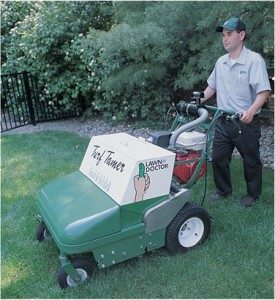Aeration in City
Aerating your lawn is one of the things you need to do to have a healthy, growing lawn. Aeration is needed due to thatch buildup and soil compaction, two problems that can be caused by a number of things, including heavy use of your yard. When soil compacts, your grass cannot breathe or find much-needed nutrients due to the compaction “suffocating” your lawn’s roots.
Lawn Doctor’s lawn aeration service can help prevent these issues and make sure y our lawn continues to flourish year round.
our lawn continues to flourish year round.
Why aerate your lawn?
Lawn aerating helps your lawn breathe; thus the name aeration. There are two ways you can aerate your lawn – spike aeration or core aeration. Spike aeration is done with a roller that has spikes in it, while core aeration, also known as plug aeration, is done with holes “cored” out of the soil. Core aerators, generally speaking, do a more thorough aeration job than spike aeration.
Aside from better air intake, some other benefits of aeration include:
- Strengthening roots
- Improving the effectiveness of lawn fertilization
- Increasing the ability for the lawn to absorb heat.
In all, your lawn will be healthier after lawn aeration. We here at Lawn Doctor offer efficient and effective lawn aeration services to help your lawn grow.
How do I know if my lawn needs to be aerated?
A simple way to tell whether your lawn needs to be aerated is the screwdriver test. Check to see if you can easily put a screwdriver or shovel in your lawn’s soil. If you can, your soil is fine. If you can only do this task with great difficulty, your soil needs to be aerated. If you have vehicles parked on the lawn, the soil also may be compacted. The same goes if puddles are forming on your lawn. Clay soils need to be aerated more than other types of soil.
When should you start aerating?
Depending on your type of grass, there are optimal times of the year to aerate your lawn. If you have a warm season grass like Buffalo or Bermuda grass, you should aerate towards the end of spring, just prior to the lawn’s peak growing season. As the lawn grows and thrives, it will fill in the holes. A cool season grass like ryegrass or Kentucky bluegrass should be aerated in the early spring or the fall. The lawn will also fill in the holes as well for the cool season grass as it grows.
Sometimes, though, if the soil is particularly compacted, you may not be able to wait until before the peak growing time. If that is the case, though, you may need to be particularly careful that weeds do not grow in the holes aerated.
How aerating a lawn works?
Our aeration experts recommend aeration when the soil is moist – water your lawn a day or two before starting the aeration process. Having a lawn too dry or wet will cause issues. In addition, core aeration and overseeding may go hand in hand – many people seed the lawn at the time they aerate. You can put seeds in the holes yourself with the use of core aerators. Many people who attempt to do this themselves rent a core aerator for a few hours. With such a machine, you can aerate the lawn with holes that are three to four inches deep, depending upon the size and type of the aerator. The machine will make sure that the holes are spaced properly apart from each other. However, it is heavy, and can be unwieldy as well as difficult to use.
Due to the cost of renting the equipment and the difficulty of using this equipment, we suggest calling your local Lawn Doctor to schedule an appointment to aerate your lawn for you. Remember, you could be spending valuable time playing golf, fishing, or out with family and friends rather than having the hassle of going to the rental store and bringing a heavy piece of equipment home. A core aeration specialist can utilize our lawn aerators to properly aerate the entire yard and make sure your lawn can breathe again. Call us today to discuss our aeration services and how they can help.
You should see a lusher, thicker lawn in the weeks and months after lawn aeration. However, you may still need to get your lawn aerated once a year or so, depending upon the lawn, in order to make sure it stays in good shape. Consult Lawn Doctor of _ about developing a proper lawn aeration schedule that fits your needs.
Click here to learn more about Aeration with overseeding.
